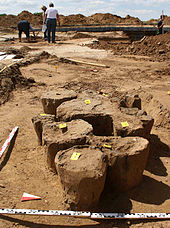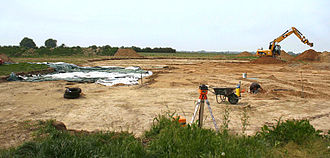Hohnhorst urn grave field
Coordinates: 52 ° 22 '26 " N , 9 ° 21' 56" E
| Hohnhorst urn grave field | ||
|---|---|---|
|
Excavation of the urn grave field Hohnhorst, 2011 |
||
| location | Lower Saxony , Germany | |
| Location | Hohnhorst | |
|
|
||
| When | pre-Roman Iron Age , around the 7th to 3rd century BC Chr. |
|
| Where | Hohnhorst , district of Schaumburg / Lower Saxony | |
The urn grave field Hohnhorst is a prehistoric grave field near Hohnhorst in the district of Schaumburg in Lower Saxony . It is during the pre-Roman Iron Age around the 7th to 3rd centuries BC. Was used as a burial place with urns . The discovery in 2011 during the construction of a biogas plant led to a two-week rescue excavation during which around 350 burials were documented. When the biogas plant was expanded in 2014, two further excavations were carried out, which led to the discovery of around 80 urns. The cemetery is one of the larger facilities of this era in northern Germany .
location
The Hohnhorst site is north of Bad Nenndorf in the northern area of the Calenberger Land on the edge of the Calenberger Lössbörde , where fertile loess soil predominates. The subsoil in the area of the former urn grave field is made up of sand , silt and boulder clay with loess lying on top. Most of the archaeological findings were in the silt layer at a depth of about half a meter.
The site is on the edge of an agricultural yard at the western end of the village outside of Hohnhorst. The surrounding, flat terrain at 56 m above sea level. NN is used for agriculture. The area of the site was used as pasture for the past 15 years and before that as a field.
Discovery and first excavation
In May 2011, construction work began to build a biogas plant north of the courtyard. When removing the topsoil , the excavator driver noticed dark circles with light fragments in the soil at a depth of about 30 cm. Since he had already dredged sites for archaeologists, he recognized the urns with burned bones. He reported the find to the builder of the facility and the responsible monument protection authority . Previous prospecting measures through an inspection and search with a metal detector had not provided any indications of archaeologically significant findings.
On the day the find was reported, employees of the municipal archeology of the Schaumburg landscape secured the first findings, which steadily increased with further soil removal. Due to the daily increasing number of finds, the archaeological capacities of local archeology were soon exhausted. Volunteers from Hohnhorst and the region as well as an archaeologist hired at short notice provided reinforcement for the rescue excavation that was initiated. In addition, an excavation team from the Lower Saxony State Office for the Preservation of Monuments was summoned to temporarily shut down its own excavation elsewhere.
During the excavation, construction work continued at the approved locations. The excavation was under great time pressure, so that the finds could not always be optimally recovered. The excavation with a total of 19 employees lasted over 11 days with 12-hour shifts. Around 600 find complexes were recovered, including around 200 block salvages from urn vessels.
Excavation area

The excavation area had a size of 60 × 30 meters. Finds were made in an area of 20 × 40 meters. The urns were particularly close together in two areas of around 50 m² each. Large parts of the urn grave field have been excavated, although the excavation was limited to the area in which the biogas plant was built. An expansion of the site to the north, west and south was ruled out due to empty areas and probes .
Finds
During the excavation, 265 urns or remains of destroyed urns were found. In most cases, the urns contained cremation and some were made of clay. The corpse burn revealed that the bones of the deceased had been picked and washed after they were burned.
Burnt nests with burned bones and no vessels were found in around 50 other places. It was to be assumed that the corpse burn was not buried in ceramic vessels, but in containers made of wood, fabric or leather, which have not survived.
A total of around 350 burials are assumed in the investigated soil area. The urns came to light from 30 cm below the surface of the earth. Numerous urns had been torn into pieces from agricultural use by plowing. Other surviving urns were deformed or cracked by the earth pressure. Among the finds was also the vessel shape of a Harpstedt rough pot , which is assigned to the Harpstedt-Nienburger group .
The grave sites had not been marked, for example by burial mounds or surrounding ditches. The urn burials partially overlapped. The size of the grave goods was modest and only a few pieces of metal and glass were found in the investigations that were not yet completed.
The extensive find material was secured with the excavation in 2011, but has not yet been made accessible. A year later, the processing of the finds began to some extent in 2012. The earth blocks of around 200 block salvages are kept safe from looting by the district of Schaumburg, but so far (2012) most of them have not yet been cleaned and examined in more detail. The same applies to the rest of the finds such as ceramic shards and grave goods.
Pottery of the Nienburger Cup type from the Hohnhorst urn burial ground Pottery of the Nienburger Cup type from the Hohnhorst urn burial ground
Nienburger cup
The pottery that has been evaluated so far included a find from a Nienburg cup . This pottery is attributed to the Nienburg group , which was located in what is now Lower Saxony during the early Iron Age from the 6th to 5th centuries BC. Formed. The Nienburger cup is a ceramic vessel that is artfully decorated and has a handle at the edge. The cultural group was named after a burial mound field in Erichshagen near Nienburg as the first place where ceramics were found.
Settlement findings
On the excavation area there were 11 findings with settlement remains that were not related to the burial ground. The building (s) could have been built before or after the burial ground was used. The remains of the settlement included seven irregularly rounded garbage pits , in each of which found objects were stored. They were three feet deep. There were also three post holes that indicate a previous, ground-level building. Another indication of a former settlement at this point was a stove. Half a meter in diameter and 30 cm high, the half-way round furnace was preserved.
presentation
The public interest in a visit and the whereabouts of the finds was served in 2012 with a small exhibition in the church in Hohnhorst. The municipality of Hohnhorst financed the restoration of five urns together with a donation from the owner of the biogas plant over several thousand euros.
Further excavations
During construction work to expand the biogas plant in July 2014, more urns were discovered in the ground, which led to another rescue excavation. 80 urns were uncovered. The archaeologists determined that the grave sites had a line-like pattern with up to ten urns on a few square meters, which they interpreted as an indication of a family association.
Archaeological investigations were again carried out during further construction work in September 2014. The circular discoloration found in the process indicated a post or support structure. On the basis of ceramic remains, the settlement finds could be assigned to the Roman Empire . Because of the distance of several centuries there is no connection to the burial ground.
Evaluation and outlook
The urn grave field Hohnhorst with up to 350 established burials is the largest facility of this type in the Schaumburg district and an important site in Lower Saxony. It is one of the few larger necropolises of the pre-Roman Iron Age in northern Germany , along with the Leese urn burial site around 25 kilometers away with around 1,100 burials and the Rüningen urn cemetery . The urn grave field Hohnhorst is assigned to the Nienburg group . The culture group is characterized by the special vessel shape of the urn type of the Nienburger cup that was found there.
The settlement that once belonged to the burial ground has not yet been located. Since higher places were preferred at that time, archaeologists suspect the settlement site on a gently sloping terrain near the site. The current location of Hohnhorst is also an option as a favorable settlement area. It is planned to develop the completed excavation in a multi-year research project by the University of Göttingen , which is to be financed with research funds. A scientific review with restoration and drawing work, anthropological studies, publications and exhibitions is planned. The aim of the research is to gain knowledge of the settlement and population of this area in the centuries before Christianity.
literature
- Jens Berthold : Excavation report on the investigation of the urn grave field of the pre-Roman Iron Age near Hohnhorst . 2011.
- Jens Berthold: Urns in Hohnhorst - Schaumburg's largest burial ground . In: Archeology in Lower Saxony . 2012 ( online ).
Web links
- Newspaper report Von Urnen und Feuersteinen from May 12, 2012 on a series of lectures on the excavation
Individual evidence
- ↑ Excavator clears ancient burial ground in Schaumburger Nachrichten of May 26, 2011
- ^ Urns from pre-Roman times kept safe in: Schaumburger Nachrichten of July 27, 2011
- ↑ We want to keep the urns in Hohnhorst in: Schaumburger Nachrichten of February 22, 2012
- ↑ Is Hohnhorst the oldest settlement in Schaumburg? in: Schaumburger Nachrichten of February 15, 2012
- ^ Burned and buried in the Schaumburger Zeitung of September 19, 2014
- ↑ Newspaper article on the working meeting of the Communal Archeology Commission of the Lower Saxony State Archaeological Association in Bückeburg in: Schaumburger Nachrichten of November 28, 2011
- ↑ Report No. 28 urn grave field Hohnhorst under contributions of the communal archeology of the Schaumburg landscape








